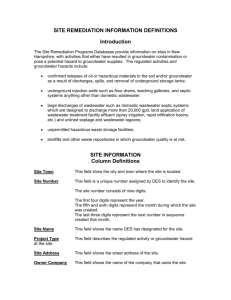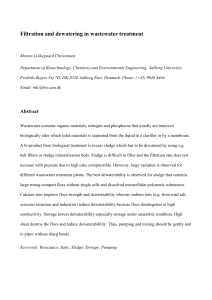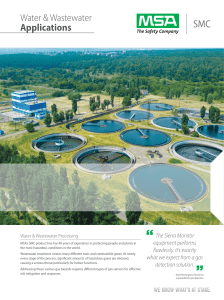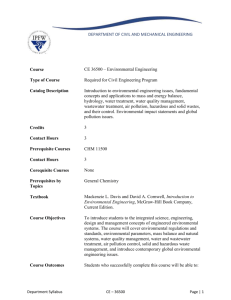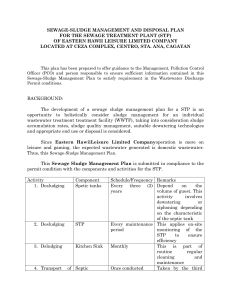FE Environmental Exam Specifications | CBT Format
advertisement
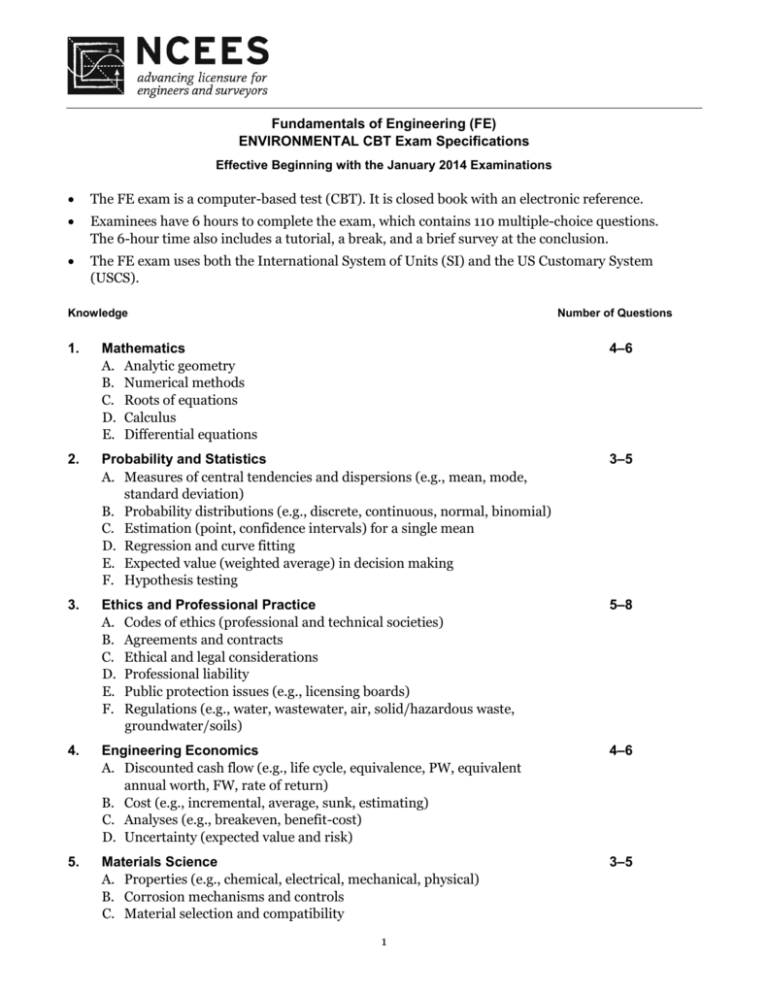
Fundamentals of Engineering (FE) ENVIRONMENTAL CBT Exam Specifications Effective Beginning with the January 2014 Examinations The FE exam is a computer-based test (CBT). It is closed book with an electronic reference. Examinees have 6 hours to complete the exam, which contains 110 multiple-choice questions. The 6-hour time also includes a tutorial, a break, and a brief survey at the conclusion. The FE exam uses both the International System of Units (SI) and the US Customary System (USCS). Knowledge Number of Questions 1. Mathematics A. Analytic geometry B. Numerical methods C. Roots of equations D. Calculus E. Differential equations 4–6 2. Probability and Statistics A. Measures of central tendencies and dispersions (e.g., mean, mode, standard deviation) B. Probability distributions (e.g., discrete, continuous, normal, binomial) C. Estimation (point, confidence intervals) for a single mean D. Regression and curve fitting E. Expected value (weighted average) in decision making F. Hypothesis testing 3–5 3. Ethics and Professional Practice A. Codes of ethics (professional and technical societies) B. Agreements and contracts C. Ethical and legal considerations D. Professional liability E. Public protection issues (e.g., licensing boards) F. Regulations (e.g., water, wastewater, air, solid/hazardous waste, groundwater/soils) 5–8 4. Engineering Economics A. Discounted cash flow (e.g., life cycle, equivalence, PW, equivalent annual worth, FW, rate of return) B. Cost (e.g., incremental, average, sunk, estimating) C. Analyses (e.g., breakeven, benefit-cost) D. Uncertainty (expected value and risk) 4–6 5. Materials Science A. Properties (e.g., chemical, electrical, mechanical, physical) B. Corrosion mechanisms and controls C. Material selection and compatibility 3–5 1 6. Environmental Science and Chemistry A. Reactions (e.g., equilibrium, acid base, oxidation-reduction, precipitation) B. Stoichiometry C. Kinetics (chemical, microbiological) D. Organic chemistry (e.g., nomenclature, functional group reactions) E. Ecology (e.g., Streeter-Phelps, fluviology, limnology, eutrophication) F. Multimedia equilibrium partitioning (e.g., Henry’s law, octonal partitioning coefficient) 7. Risk Assessment A. Dose-response toxicity (carcinogen, noncarcinogen) B. Exposure routes 8. Fluid Mechanics A. Fluid statics B. Closed conduits (e.g., Darcy-Weisbach, Hazen-Williams, Moody) C. Open channel (Manning) D. Pumps (e.g., power, operating point, parallel and series) E. Flow measurement (e.g., weirs, orifices, flowmeters) F. Blowers (e.g., power, operating point, parallel, and series) 9. Thermodynamics A. Thermodynamic laws (e.g., 1st law, 2nd law) B. Energy, heat, and work C. Ideal gases D. Mixture of nonreacting gases E. Heat transfer 10. Water Resources A. Demand calculations B. Population estimations C. Runoff calculations (e.g., land use, land cover, time of concentration, duration, intensity, frequency) D. Reservoir sizing E. Routing (e.g., channel, reservoir) F. Water quality and modeling (e.g., erosion, channel stability, stormwater quality management) 11. Water and Wastewater 14–21 A. Water and wastewater characteristics B. Mass and energy balances C. Conventional water treatment processes (e.g., clarification, disinfection, filtration, flocculation, softening, rapid mix) D. Conventional wastewater treatment processes (e.g., activated sludge, decentralized wastewater systems, fixed-film system, disinfection, flow equalization, headworks, lagoons) E. Alternative treatment process (e.g., conservation and reuse, membranes, nutrient removal, ion exchange, activated carbon, air stripping) F. Sludge treatment and handling (e.g., land application, sludge digestion, sludge dewatering) 2 11–17 5–8 9–14 3–5 10–15 12. Air Quality 10–15 A. Chemical principles (e.g., ideal gas, mole fractions, stoichiometry, Henry’s law) B. Mass balances C. Emissions (factors, rates) D. Atmospheric sciences (e.g., stability classes, dispersion modeling, lapse rates) E. Gas handling and treatment technologies (e.g., hoods, ducts, coolers, biofiltration, scrubbers, adsorbers, incineration) F. Particle handling and treatment technologies (e.g., baghouses, cyclones, electrostatic precipitators, settling velocity) 13. Solid and Hazardous Waste A. Composting B. Mass balances C. Compatibility D. Landfilling (e.g., siting, design, leachate, material and energy recovery) E. Site characterization and remediation F. Hazardous waste treatment (e.g., physical, chemical, thermal) G. Radioactive waste treatment and disposal 14. Groundwater and Soils A. Basic hydrogeology (e.g., aquifers, permeability, water table, hydraulic conductivity, saturation, soil characteristics) B. Drawdown (e.g., Jacob, Theis, Thiem) C. Groundwater flow (e.g., Darcy’s law, specific capacity, velocity, gradient) D. Soil and groundwater remediation 3 10–15 9–14


